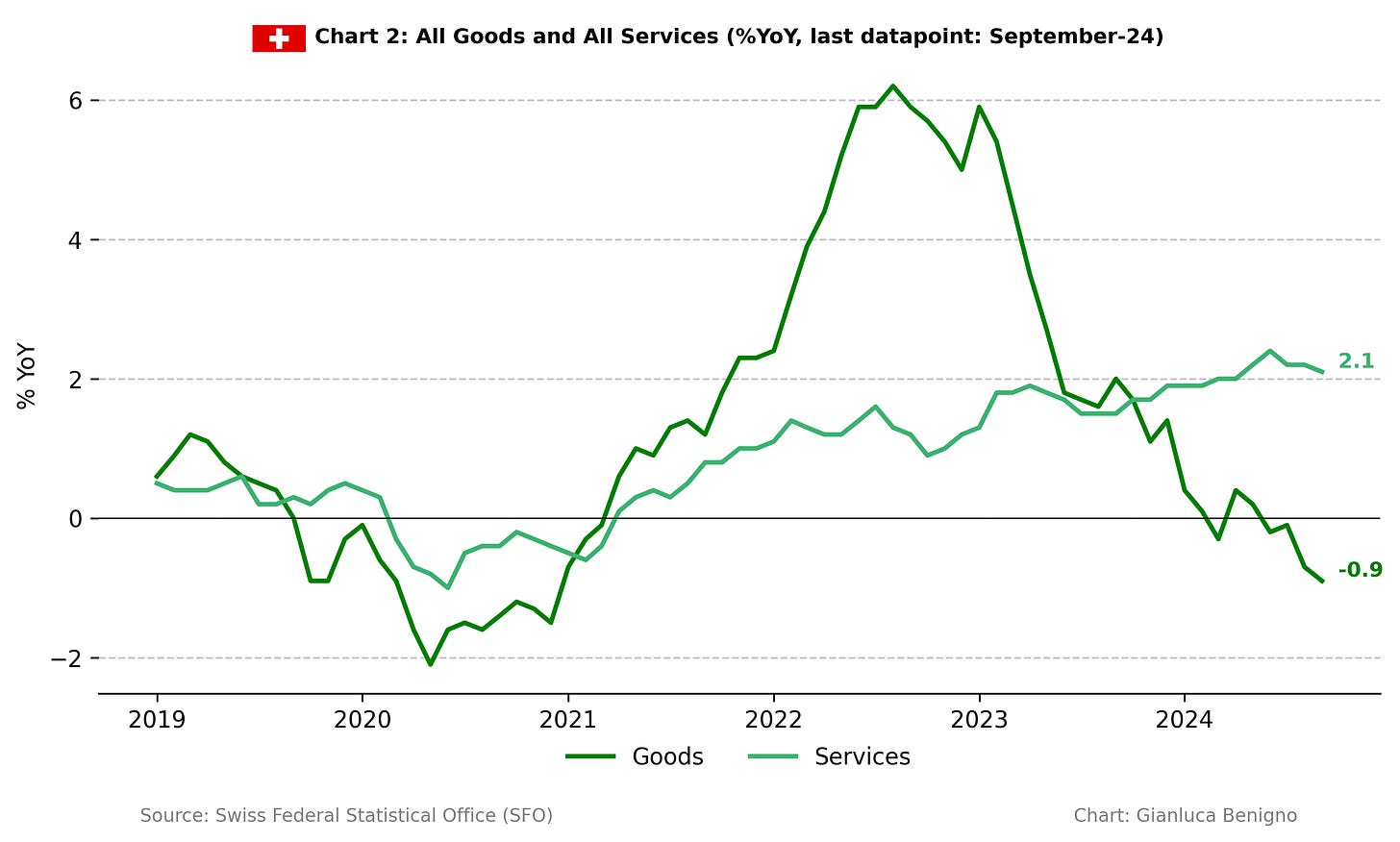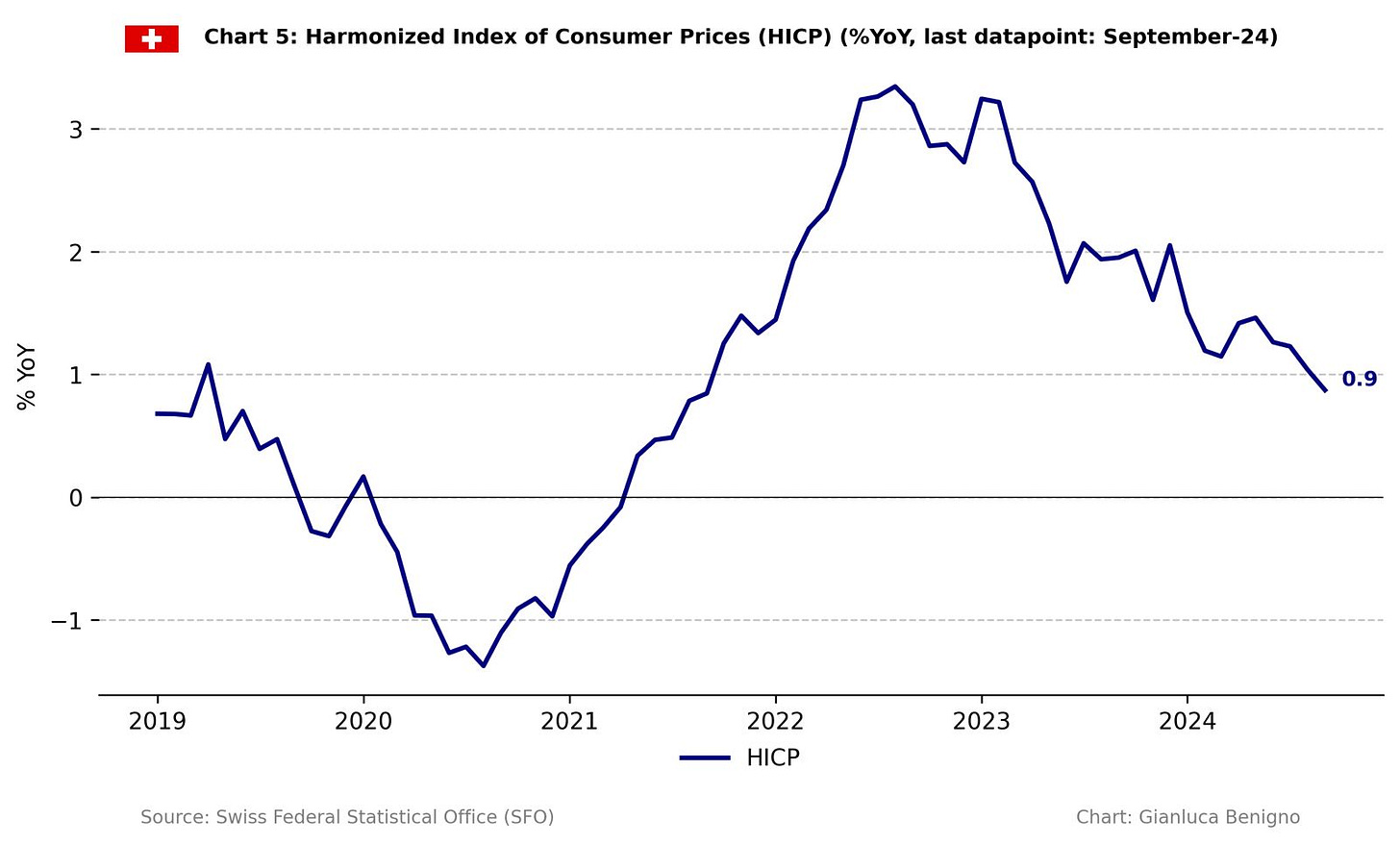Switzerland September-24 CPI Inflation Report
Persistent downside pressures on inflation in Switzerland
Key takeaways:
In September, the Swiss Consumer Price Index (CPI) rose by 0.8% year-on-year (YoY), lower than August's 1.1% YoY figure and the consensus forecast of an increase of 1% YoY. On a month-on-month (MoM) basis, the headline CPI declined by 0.3%, compared with a 0% MoM decrease in August.
The Core CPI increased by 1.0% YoY in September, lower than the 1.1% YoY observed in August, and the consensus of 1.1% YoY. However, it showed a month-on-month decline of -0.2%.
The primary driver of rising prices was the services sector, which experienced a 2.1% YoY increase in September. In contrast, the goods sector declined for the fifth time in 2024, with a decrease of 0.9% YoY versus a decline of 0.7% YoY in August.
Housing rentals have trended upward since November 2023. In September, the increase was 4.0 % YoY (the highest since November 1993), higher than the 3.4% YoY recorded in the previous observation. As noted previously, this further increase in housing rental inflation is consistent with the Catch-22 effect where monetary policy hikes lead to sectoral inflationary pressures.
These results are consistent with a common dichotomy faced by Central Banks in (major) advanced economies: goods prices are in a deflationary territory while service price inflation is slowly adjusting.
A parallel dichotomy arises in Switzerland by examining import and domestic prices, with import prices declining by 2.7% YoY (versus a 1.9% YoY decline in August) and domestic prices rising at 2% YoY (the same rate as the 2% YoY recorded in August).
From the SNB's perspective, the current data is consistent with the significant revision of the conditional inflation path outlined in its latest monetary policy assessment. Further interest rate cuts and foreign exchange interventions may be necessary to counteract deflationary pressures from import prices, as well as emerging signs of deflation (on a month-to-month basis) in certain domestic categories.
Related Posts
The SNB’s Forward-Looking Compromise (analysis of SNB’s September policy decision)
Switzerland August 24-CPI Inflation Report (previous release)
The SNB’s Challenging Rebalancing Act (analysis of SNB policy and Catch-22 effect for the SNB)
The SNB sets the time (analysis of SNB policy and Catch-22 effect for the SNB)
Switzerland July 24-CPI Inflation Report (previous release)
UK August 24-CPI Inflation Report (other release).
Review of the Inflation Release
Consumer prices rose by 0.8% year-on-year (YoY) in September 2024, below August’s increase of 1.1% YoY. On a month-on-month (MoM) basis, consumer prices declined by 0.3% YoY, following a 0% change in August.
Core CPI, which excludes fresh and seasonal products as well as energy and fuels, increased by 1% year-on-year (YoY) in September (Chart 1), lower than the 1.1% YoY observed in August. On a month-on-month basis, Core CPI declined by 0.2%, compared to a 0.1% increase in August.
Similarly to trends seen in other advanced countries, the services sector, rather than the goods sector, is the main driver of rising prices (Chart 2). In September, services saw a 2.1% YoY increase, lower than the 2.2% recorded in August. Meanwhile, the goods sector experienced a decline of 0.9% YoY, following a 0.7% YoY decline in August.
Upon examining the more disaggregated data (refer to Tables 1 and 2), it is evident that, like other advanced economies, housing rentals are the primary driver of inflation (as shown in Chart 3). In Switzerland, this component of the Consumer Price Index (CPI) is adjusted every three months and August is the month in which the new three-month data point is reported. In September the housing rental component had the same value as in August (a 4% increase year-on-year compared with the 3.4% YoY reported in July, June, and May). As noted previously, the upward trend in housing rental is consistent with the Catch-22 effect where monetary policy hikes lead to higher mortgage rates that tend to exacerbate domestic inflation. Excluding housing rentals, in September the CPI inflation increased by 0.1% year-on-year sensibly lower than the 0.4% YoY increase reported in August, and the 0.8% recorded in July.
Another important classification from Switzerland's perspective is the distinction between domestic and imported inflation (see Chart 4). In September, domestic inflation rose by 2% year-on-year, the same rate recorded in August. On a monthly basis, domestic inflation declined by 0.2% MoM, lower than the 0% MoM reported in August 2024. In contrast, imported inflation decreased by 2.7% year-over-year, which is a lower decrease than the -1.9% recorded in August. On a monthly basis, imported inflation fell by 0.5%, compared to the -0.1% seen in August.
The Swiss Federal Statistical Office also makes available a measure of the Harmonized Price Index of Consumer Prices (The Harmonized Index of Consumer Prices (HICP) is an indicator that the member states of EU and EFTA calculate based on a harmonized method and that allows comparing inflation internationally). The HICP has increased by 0.9% on a year-on-year basis, slightly below the 1% recorded in August.
Summary
The report presents a more pronounced disinflationary outlook than what was anticipated by consensus and is in line with the latest monetary policy assessment by the SNB. In addition to the ongoing deflationary trend in goods and the effects of imported inflation, it's important to highlight the decline in service and domestic inflation on a month-to-month basis. Moreover, excluding the rent component, inflation remains barely positive, standing at just 0.1% year-over-year. This month's report follows last week's monetary policy decision by the Swiss National Bank (SNB) that lowered the interest on sight deposits by another 25 basis points, in line with the cuts made in March and June. As discussed in “The SNB’s Forward-Looking Compromise” this more pronounced disinflationary pressure would require a combination of further rate cuts and increased foreign exchange intervention given the strength of the Swiss Franc.
Table 1: CPI by components (% YoY)
Source: Swiss Federal Statistical Office (FSO).
Table 2: CPI by components (% MoM)
Source: Swiss Federal Statistical Office (FSO).










